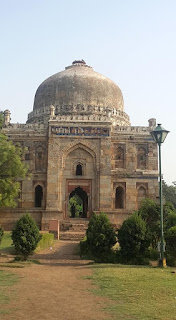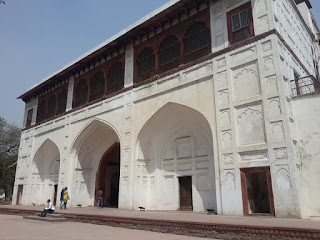Monday, March 9, 2020
Lodhi Gardens and Tombs
Delhi Heritage Trail 19
Lodhi Garden and Tombs
Situated in the heart of Delhi at an 80 acre expanse the Lodhi Gardens is the green heart of Delhi and a place of leisure for the elite Lutyens Delhi. A morning walk in the garden takes you to a different world. The garden they say is home to a myriad of birds including Cuckoos, Black Myna, Woodpecker, Hornbills and House Sparrows. The different sounds made by these birds combine for a early morning Raga to be enjoyed. You can see a group of middle aged Ladies and Gents practising yoga to commands from their master and a lonely old man laughing out loudly and continuously to relieve his stress.
The present Garden was once a village called Khairpur and home to Tombs of the 15th century rulers of Sayyid and Lodi Dynasties of Delhi. They erected beautiful tombs where the Sultans including Mohammed Shah Sayyid (1434-1445) Sikandar Lodi (1489-1517) and a host of their nobles are interred. The present gardens were developed around the Tombs by evicting the villagers of Khairpur in 1936 when New Delhi was being developed during the Governorship of Lord Willingdon. It was again redeveloped in 1968.
Red Fort (Lal Qila)
Delhi Heritage Trail 18
Red Fort (Lal Qila)
This more than 300 year old was built by Shajahan since he wanted to shift the capital from Agra as it was overcrowded. The construction started around 1638 and was completed in the year 1648. Compared to Agra Fort Lal Qila or Red Fort is not that grand. Over a period of time due to invasion of Nadir Shah in 1739 and after the Sepoy Mutiny in 1857 many of the grand buildings inside the Fort were demolished. The British built many barracks in the Fort after demolition of the old buildings after 1857 which are out of place in this heritage site. Only a very few 17th century buildings are left in the Fort like Meena Bazar, Naubat Khana, Diwani-i-Am, Diwani-i-Khas, Rang Mahal, Zafar Mahal, Moti Masjid, Khizri Gate. These buildings are maintained well by the ASI.
Meena Bazaar: This Bazaar was an exclusive retail bazaar which was frequented in 17th and 18th century by the Moghul nobles of the Fort
Naubat Khana : This was also called Drum House were the Musicians of the Fort played whenever there was an occasion or when the King was moving in or out of the Fort
Diwani-i-Am : The hall of public Audience where the King met common people to hear their grievances.
Diwani-i-Khas: The marble hall where the king met the important nobles.
Zafar Mahal : This was built by last Moghul king in 1842 where he used to sit hours together for writing poems.
Moti Masjid : The private masjid of Aurangazeb
Rang Mahal : The place of entertainment.
Khizri Gate : This was the underground gate from Yamuna through which Shajahan entered the Fort in 1648 after its completion for the first time. This is also the gate through which Bahadur Shah Zafar II escaped on 20th September 1857 from the Fort to be caught 3 days later at Humayuns Tomb by Major Hudson.
At James Church Copper Ball
Delhi Heritage Trail 17
The Copper Ball and Cross in St James Church, Kashmere Gate
This Copper Ball and Cross were originally at the top of the central dome of St . James Church, Kashmere Gate. During the Sepoy mutiny of 1857 the church was heavily damaged when the rebels and British had to resort to do or die battle in nearby Kashmere gate. The Copper Ball was severely pierced and damaged by the bullets and after the mutiny they were reconstructed and every effort was made to maintain the original shape. Many of the British Officers and soldiers who lost their lives during mutiny lie buried here including British Commissioner of Delhi at that time Sir William Fraser.
Wednesday, January 8, 2020
Qutub Minar
Delhi Heritage Trail : 16
Qutub Minar
Qutub Minar the tallest stone tower in the Indian subcontinent. It is situated on the southern suburb of Delhi near Mehrauli. The construction of the tower was started in the year 1192 by Qutbuddin Aibak the founder of Slave dynasty near Quwwat ul Islam Mosque. During his lifetime only the first storey of the tower was completed made of red sandstone.
The second, third and fourth storey were constructed by his successor Iltumish(1211-36). It was struck by a major lightening in the year 1368 during the period of Firuz Shah Tughlaq and the fourth storey was damaged . It was replaced by him along with an additional fifth storey. Later in 1503 Sikandar Lodhi of the Lodhi dynasty renovated the top stories with marble stones.
The total height of the Minar is 238 feet and there are 329 revolving steps inside it to go to the top. The angular and circular fluttings on the lower storeys, projecting balconies and decorative inscriptions on the walls add to its beauty. It is said artisans from Samarkand and Bukhara in the middle east Asia were brought to do the decorations.
Another major earthquake struck the Minar in 1803 and the top Cupola was damaged. The East India Company Governor General authorised Major Robert Smith Garrison Engineer stationed at Delhi to do the repair. He replaced the top with a Hindu style Cupola and work was completed by 1828. But it was not in tune with the Islamic architecture of the Minar and ultimately in 1848 Lord Hardinge ordered the removal of it and it now lies in the corner of the ground. It used to be called Smiths folly.
Our people are enamoured by the modern day skyscrapers of the western hemisphere without appreciating the one in our backyard constructed 800 years back.
Monday, January 6, 2020
Fatehpuri Masjid
Delhi Heritage Trail : 15
Fatehpuri Masjid
This 17th century Masjid is situated at the far end of Chandni Chowk leading from Red Fort. It was built in the year 1650 by Fatehpuri Begum one of the 14 wives of Shahjahan. It was the oldest Masjid in the city of Shahjahanabad which was started around 1640 by Shahjahan. The design and structure of the Masjid is similar to Juma Masjid with an almost similar square yard with entrances on three sides and a cupola near the main entrance and minars in the Corners.
After the Mutiny of 1857 the Britishers badly treated the Masjid and sold it to Lala Chunna Mal a leading Banker of 19th century Delhi. It was restored to Muslims in 1877 for regular worship. The antipathy against the Muslims after Mutiny helped the Hindus and Chunna Mal became an important figure in local Government. His 150 year old Haveli is also situated near by.
The area around Fatehpuri Masjid consists of a network of tiny lanes with a lot of wholesale and retail shops selling Spices and Dry fruits with head loaders, hand carts and cycle rickshaws zipping around. The aroma of the spices and dry fruits is inviting and you are taken back to an era of more than hundred years and old world charm which can only be experienced
Kashmere Gate
Delhi Heritage Trail : 14
Kashmere Gate
This is one of the 14 gates of Shajahanabad built by Moghul emperor Shahjahan in 17th century. It was named so because it was leading the road to Kashmir from Delhi. The gate was close to the river and the place around it was used by the Nobles and Courtiers in the Moghul court to build their country houses. Dara Sukoh the brother of Aurangazeb had his Mango Grove nearby.
During the Moghul period there was a Custom house near the gate to collect taxes on trade running through the gate. When the mutineers captured Delhi in 1857 they heavily fortified the gate. The British troops under Brigadier John Nicholson heavily bombarded the bastions, walls and gates around the Kashmere gate. Even now the dent made by the cannon balls can be seen. The siege continued for 4 months and ultimately the gate was breached on 14th September 1857 by Nicholson and his troops. He died in the battle and was buried in the nearby Nicholson Cemetery.
The gate is now an ASI protected monument. The gate is just outside Kashmere Gate metro station.
Subscribe to:
Comments (Atom)

























